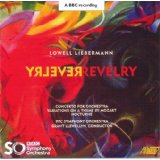Concerto for Orchestra Op. 81 (2002) c. 32'00"
(3.3.3.3/4.3.3.1/timp/perc(5)/hp/pno d cel/strings)
in one movement
The Concerto for Orchestra was commissioned by the Edward H. Schmidt Musical Arts Fund of the Toledo Symphony
First performed on September 20, 2002 at the Peristyle Theater in Toledo, Ohio by the Toledo Symphony conducted by Grant Llewellyn.
ABOUT
Concerto for Orchestra Op. 81 was commissioned by by the Toledo Symphony Orchestra through the Edward H. Schmidt Musical Arts Fund. The world premiere took place on September 20th, 2002, with the Toledo Symphony Orchestra conducted by Grant Llewellyn. The Concerto was completed in June of 2002. It is in three connected movements that share thematic and motivic material. The Concerto is scored for a standard orchestra with expanded percussion: Piccolo, 2 Flutes, 2 Oboes, English Horn, 2 Clarinets, Bass Clarinet, 2 Bassoons, Contrabassoon, 4 Horns, 3 Trumpets, 3 Trombones, Tuba, Harp, Piano (doubling Celesta) Timpani, Strings, and 5 Percussionists playing Slapstick, Claves, Snare Drum, Cymbals, Bass Drum, Cowbell, Tubular Bells, Marimba, Xylophone, Woodblock, Vibraphone, Glockenspiel, Bongo Drums, Large Gong, Tambourine, Ratchet, Brakedrum, Triangle and Vibraslap.
The work opens with a slow introduction that outlines an octotonic (8-note) scale from which much of the material of the Concerto is built. Motivic fragments are also introduced that are expanded later in the work. The body of the first movement is an expanded A-B-A form: a relentless Vivace with many meter changes and tricky cross-rhythms flanks a contrasting lyric section. An abrupt pause leads the slow movement, a sectional Adagio that builds on motivic fragments heard earlier. This leads directly into the final movement, an Allegro which juxtaposes a fanfare-like motive in the horns with a chorale theme built on the octotonic scale that is varied in a Passacaglia-like fashion and fugal sections built previous material.
Many people have a hard time grasping the concept of a “Concerto” for orchestra, and I have been asked may times since I started working on the piece what the difference was between a Concerto for Orchestra and a Symphony. Of course, usually a Concerto features a solo instrumentalist with orchestra as opposed to a Symphony which is usually without soloist. In writing a Concerto without soloist, my aim was to stress the virtuosity of the orchestra, not only by featuring solo players within the orchestra, but especially by featuring the virtuosity of the orchestra as an ensemble. In fact the ensemble difficulties of the work, particularly in the first movement, are such that I was almost tempted to call the piece “Concerto for Conductor and Orchestra.”
RECORDINGS
click on thumbnail to order
REVIEWS
“this is an expertly crafted virtuoso essay that gives everyone a moment to shine at some point, and it’s a tribute to Liebermann’s technique that even the odder instruments make sense in their context”
Classics Today
“Alternately rich and gritty in harmonic and melodic content, Liebermann’s youthfully optimistic Concerto for Orchestra is a virtuoso piece from start to finish. The conceptual idea behind such a work is to treat every member, or at least each section, of the orchestra as a soloist. Liebermann accepted this challenge with a vengeance. From the dark cello motif that opened the work, the score constantly pitted one section of the orchestra against another. Listening to the work develop, one often felt as if some spectacular clash of wills was unfolding across the stage. Melodies - sometimes long, more often shattered into agitated fragments - broke across each other in clashing rhythms that reminded this listener of the Greek Furies.”
The Toledo Blade
